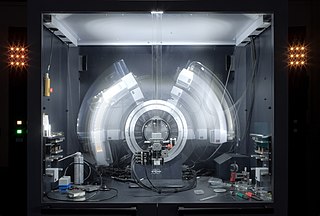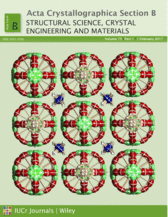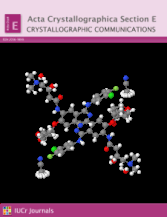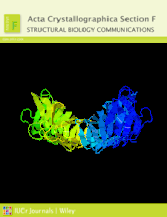
X-ray crystallography is the experimental science of determining the atomic and molecular structure of a crystal, in which the crystalline structure causes a beam of incident X-rays to diffract in specific directions. By measuring the angles and intensities of the X-ray diffraction, a crystallographer can produce a three-dimensional picture of the density of electrons within the crystal and the positions of the atoms, as well as their chemical bonds, crystallographic disorder, and other information.
Electron crystallography is a subset of methods in electron diffraction focusing upon detailed determination of the positions of atoms in solids using a transmission electron microscope (TEM). It can involve the use of high-resolution transmission electron microscopy images, electron diffraction patterns including convergent-beam electron diffraction or combinations of these. It has been successful in determining some bulk structures, and also surface structures. Two related methods are low-energy electron diffraction which has solved the structure of many surfaces, and reflection high-energy electron diffraction which is used to monitor surfaces often during growth.
The TB Structural Genomics Consortium (TBSGC) is a worldwide consortium of scientists developing a foundation for tuberculosis diagnosis and treatment by determining the three-dimensional structures of proteins from M. tuberculosis founded in 2000 as a part of the Protein Structure Initiative. The consortium seeks to solve structures of proteins that are of great interest to the TB biology community. A major goal of the consortium is to have a putative function for every ORF in the TB genome.
Thomas Alwyn Jones (born 30 August 1947) is a Welsh biophysicist and a professor at the Uppsala University in Sweden.
Acta Crystallographica is a series of peer-reviewed scientific journals, with articles centred on crystallography, published by the International Union of Crystallography (IUCr). Originally established in 1948 as a single journal called Acta Crystallographica, there are now six independent Acta Crystallographica titles:

Acta Crystallographica Section B: Structural Science, Crystal Engineering and Materials publishes scientific articles on structural science. According to the journal: "Knowledge of the arrangements of atoms, including their temporal variations and dependencies on temperature and pressure, is often the key to understanding physical and chemical phenomena and is crucial for the design of new materials and supramolecular devices." It was formed in 1968 when the journal Acta Crystallographica was split into two parts and has been published for the International Union of Crystallography under the following titles:

Acta Crystallographica Section E: Crystallographic Communications is an open-access structural communications journal. It reports crystal structure determinations of inorganic, metal-organic and organic compounds. Since 2012, Acta Crystallogr. E has not been included in the Science Citation Index.

Acta Crystallographica Section C: Structural Chemistry is a journal for the rapid publication of research with structural content relating to the chemical sciences.
A crystallographic database is a database specifically designed to store information about the structure of molecules and crystals. Crystals are solids having, in all three dimensions of space, a regularly repeating arrangement of atoms, ions, or molecules. They are characterized by symmetry, morphology, and directionally dependent physical properties. A crystal structure describes the arrangement of atoms, ions, or molecules in a crystal..

Acta Crystallographica Section A: Foundations and Advances is a peer-reviewed structural science journal published bimonthly by the International Union of Crystallography. It contains papers describing fundamental developments in structural science. It was founded in 1967 when Acta Crystallographica was split into two sections, and was initially titled Acta Crystallographica Section A: Crystal Physics, Diffraction, Theoretical and General Crystallography. The journal's name changed in 1982 to Acta Crystallographica Section A: Foundations of Crystallography. The journal adopted its current title in 2013.

Acta Crystallographica Section F is a rapid structural biology communications journal. It publishes short papers on biological structures and any aspects of structural biology.

Mamannamana Vijayan was an Indian structural biologist.

The Journal of Applied Crystallography is a peer-reviewed scientific journal published by Wiley-Blackwell on behalf of the International Union of Crystallography. It was established in 1968 with André Guinier as the founding editor. The journal covers the application of crystallography and crystallographic techniques. William Parrish (1914–1991) chaired the committee that started the journal.

Macromolecular structure validation is the process of evaluating reliability for 3-dimensional atomic models of large biological molecules such as proteins and nucleic acids. These models, which provide 3D coordinates for each atom in the molecule, come from structural biology experiments such as x-ray crystallography or nuclear magnetic resonance (NMR). The validation has three aspects: 1) checking on the validity of the thousands to millions of measurements in the experiment; 2) checking how consistent the atomic model is with those experimental data; and 3) checking consistency of the model with known physical and chemical properties.

Randy John Read is a Wellcome Trust Principal Research Fellow and professor of protein crystallography at the University of Cambridge.

The Disordered Structure Refinement program (DSR), written by Daniel Kratzert, is designed to simplify the modeling of molecular disorder in crystal structures using SHELXL by George M. Sheldrick. It has a database of approximately 120 standard solvent molecules and molecular moieties. These can be inserted into the crystal structure with little effort, while at the same time chemically meaningful binding and angular restraints are set. DSR was developed because the previous description of disorder in crystal structures with SHELXL was very lengthy and error-prone. Instead of editing large text files manually and defining restraints manually, this process is automated with DSR.
Oluwatoyin (Toyin) Asojo currently Associate Director for Diversity, Equity, Inclusion, and Belonging at Dartmouth Cancer Center was formerly Associate Professor and chair of the Department of Chemistry and Biochemistry at Hampton University. She was formerly an Associate Professor of Pediatrics-Tropical medicine at the Baylor College of Medicine. She works at "the interface of math, chemistry, biology, computation." She is a crystallographer and interested in structural studies of proteins from neglected tropical disease pathogens.

Mercury is a freeware developed by the Cambridge Crystallographic Data Centre, originally designed as a crystal structure visualization tool. Mercury helps three dimensional visualization of crystal structure and assists in drawing and analysis of crystal packing and intermolecular interactions. Current version Mercury can read "cif", ".mol", ".mol2", ".pdb", ".res", ".sd" and ".xyz" types of files. Mercury has its own file format with filename extension ".mryx".
Robert Day Shannon is a retired research chemist formerly at DuPont de Nemours, Inc.
Alexander Frank Wells, or A. F. Wells, was a British chemist and crystallographer. He is known for his work on structural inorganic chemistry, which includes the description and classification of structural motifs, such as the polyhedral coordination environments, in crystals obtained from X-ray crystallography. His work is summarized in a classic reference book, Structural inorganic chemistry, first appeared in 1945 and has since gone through five editions. In addition, his work on crystal structures in terms of nets have been important and inspirational for the field of metal-organic frameworks and related materials.












